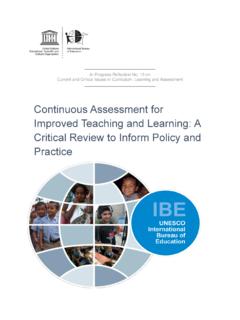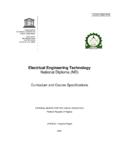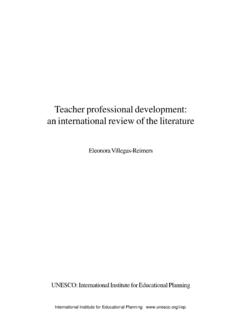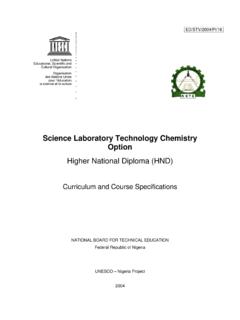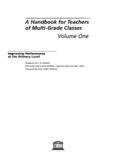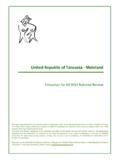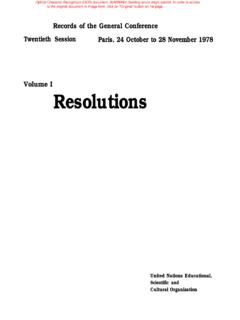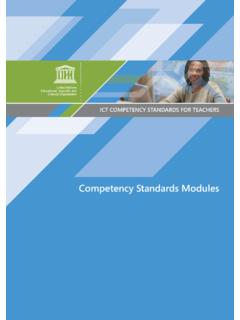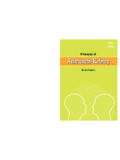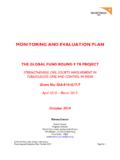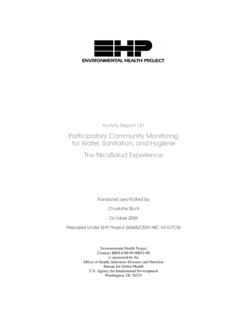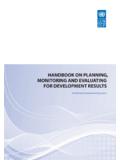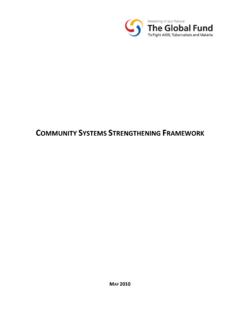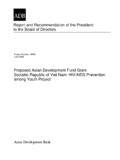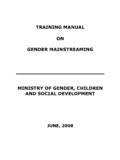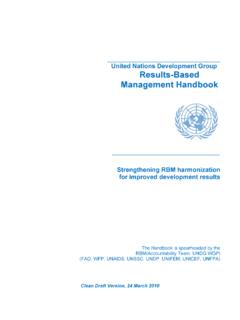Transcription of Philippine Education for All 2015 review report; 2015
1 Philippines Education for All 2015 National review This report was prepared by the relevant national authorities in view of the World Education Forum (Incheon, Republic of Korea, 19 22 May 2015). It was submitted in response to UNESCO's invitation to its Member States to assess progress made since 2000 towards achieving Education for All (EFA). The views and opinions expressed in this document are those of the authors and do not commit UNESCO. The designations employed and the presentation of material do not imply the expression of any opinion whatsoever on the part of UNESCO concerning the legal status of any country, territory, city or area or of its authorities, or concerning the delimitation of its frontiers or boundaries. The paper can be cited with the following reference: Education for All 2015 National review Report: Philippines.
2 For further information, please contact: Table of Contents List of Figures vii List of Tables viii List of Boxes viii Acronyms and Abbreviations ix Glossary xv Acknowledgments xvii Executive Summary xix Chapter 1: Introduction 1. Background 1. The Philippines' development context: The Philippine Development Plan (PDP) 4. 2011-2016. Education sector development and challenges 6. Governance of Basic Education Act of 2001 6. The Kindergarten Act and the Enhanced Basic Education Act 6. Financing Education 7. Major policies, strategies and interventions for Education and learning 8. Philippine EFA 2015 National Plan of Action 8. The Basic Education Sector Reform Agenda (BESRA) 9. Ten-Point Education agenda 10. The relevance of EFA 11.
3 Chapter 2: Tracking the Progress of Philippine EFA 2015 13. Goal 1: Achieving Early Childhood Education (ECE)/Early Childhood Care and De- 13. velopment (ECCD) National Policies on ECCD 14. Care and Education services for children below 5 years old 14. Goal 2: Achieving universal primary/basic Education 16. Policies to universalize basic Education 16. Progress to attain universal basic Education 17. Philippine Education for All 2015 review Report iii Policies and programs to reach more children 19. Progress in keeping school-age children in school 23. Policies and programs to keep children in school 26. Instituting inclusive Education 28. Goal 3: Achieving learning and life skills for youth and adults 30. Technical-vocational Education of DepEd 30.
4 Technical-vocational and Education and training (TVET) of Technical Education 32. and Skills Development Authority (TESDA). Goal 4: Achieving adult literacy 34. Eradicating illiteracy 34. Literacy of Filipinos 34. Community-based lifelong learning for OSC, OSY and adults through the 37. Alternative Learning System Non-DepEd support for literacy programs 40. Local government literacy programs 40. Literacy programs of NGOs and other agencies 41. Goal 5: Achieving gender parity and equality: 42. Policies on gender and development 42. Literacy rate by gender 42. Gender parity in ECCD 44. Gender parity in formal Education 44. Gender parity per type of Education and training program 45. Goal 6: Achieving quality of Education 46. Addressing Education input gaps 46.
5 Utilizing quality enhancing tools in Education 48. Instituting teacher quality 48. Improving learning outcomes 50. Gauging quality Education 50. Chapter 3: review of EFA Strategies and Sector Management: 53. EFA Production and Enabling Task Progress Production Task 1: Make every school continuously perform better 53. Production Task 2: Expand ECCD coverage to yield more EFA benefits 55. iv Philippine Education for All 2015 Assessment Production Task 3: Transform non-formal and informal learning interventions into 56. an alternative learning system yielding more EFA benefits Production Task 4: Promote practice of high quality teaching 57. Production Task 5: Adopt a 12-year program for formal basic Education 59. Production Task 6: Accelerate articulation, enrichment and development of the 61.
6 Basic Education curriculum Enabling Task 7: Provide adequate and stable public funding for the country-wide 62. attainment of EFA goals Financing to attain quality Education for all 62. LGU financing for Education 63. EFA funds from international donors 64. Adopt-a-School program 65. Enabling Task 8: Create a network of community-based groups for local 67. attainment of EFA goals The National Education for All Committee (NEC) , the Regional Committee 67. on Education for All (RCEFA), and the Division Committee on Education for All (DCEFA). The Literacy Coordinating Council (LCC) 67. Local School Boards (LSBs) 68. School Governing Councils (SGCs) 68. Enabling Task 9: Monitor progress in efforts towards attainment of EFA goals 69.
7 EFA assessments 69. Surveys 70. Information systems 70. Literacy awards 71. Chapter 4: Challenges and Government Priorities 73. Struggles and obstacles: what makes EFA a challenge in the Philippines? 73. Government plans and actions 74. Poverty reduction and inclusive growth programs 74. Climate change adaptation and mitigation and disaster preparedness 75. Peace process 76. Protecting Filipino children 77. Philippine Education for All 2015 review Report v Chapter 5: Conclusion and Recommendations 79. Recapitulation of major findings and conclusions 79. Education as the country's development strategy 79. Promising Education reforms 79. Policies that support EFA 79. The EFA Grand Alliance at work 80. Inclusive Education 80. Remaining gaps 80.
8 EFA Acceleration Plan 81. Key broad strategies 81. EFA 2015 funding 82. Monitoring and evaluation 82. Recommendations for Goal 1 82. Recommendations for Goal 2 83. Recommendations for Goal 3 84. Recommendations for Goal 4 85. Recommendations for Goal 5 85. Recommendations for Goal 6 85. For 2015 and Beyond: Reforms to Improve Philippine EFA 86. Improving EFA monitoring and evaluation 86. Revitalizing the purpose of ALS 86. Evaluating the effectiveness of ADMs 86. Raising the standards of ECCD programs and services 86. Improving quality kindergarten to 12 years basic Education curriculum, 87. assessment, and teacher development Enhancing the teaching and learning methods 87. Utilizing ICT for Education 87. Improving disaster resilience and response 87.
9 Strengthening Education organizations/institutions 88. References 89. vi Philippine Education for All 2015 Assessment List of Figures Figure 1 The National EFA 2015 review Process 2. Figure 2 The Enhanced Basic Education Program 6. Figure 3 Gross and Net Enrolment Rates, Kindergarten, 18. SY 2006-2007 to 2012-2013 Figure 4 Gross and Net Enrolment Rates, Elementary and Secondary, 19. SY 2001-2002 to 2012-2103 Figure 5 Completion Rates, Elementary and Secondary, 24. SY 2005-2006, 2012-2013 Figure 6 Cohort Survival Rates, Elementary and Secondary, 25. SY 2005-2006, 2012-2013 Figure 7 Percentage of Students per Tec-Voc Subject, Public Schools, 31. SY 2012-2013 Figure 8 Number of Technical Vocational Education and Training (TVET) 32.
10 Beneficiaries Figure 9 Certified Skilled/Tech-Voc Workers by Sector, 2012 33. Figure 10 Basic and Functional Literacy Rates, 2003 and 2008 35. Figure 11 Functional Literacy Rate, by Age Group, 2008 36. Figure 12 Highest Educational Attainment, by Age Bracket, by Level 36. of Education , in Percentage, 2008 Figure 13 Alternative Learning System Enrollees, Completers, 38. A&E Test-Takers and Passers, 2005-2013 Figure 14 Types of ALS Delivery Mechanisms, 2013 39. Figure 15 Percentage of Population by Highest Educational Attainment, 43. and by Sex, 2008 Figure 16 Basic and Functional Literacy Rates, by Sex, and by Year, 43. 2003 and 2008 Figure 17 National Achievement Test (NAT), Mean Percentage Score (MPS), 50. Elementary and Secondary, SY 2005-2006 to 2012-2013 Figure 18 K to 12 Reform Program 60.
